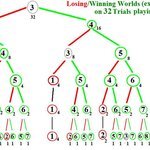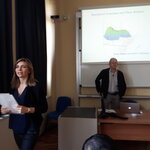Mathematics

In 2012 we had an uneventful election which was so easy to predict absolutely no one neutral got it wrong. But it was heralded as a victory for scientific polling and a new era for predictive analysis.
But it was really just an incumbent with a placeholder opponent. Every poll nearly ran the table predicting the states President Obama would win. I even lost a bet to science journalist Razib Khan because he correctly stated that the American public was even more predictable than I believed. I was so confident that the battleground states had not been decided before election day I even spotted…

Have you read this week a claim by the Harvard School of Public Health that Food Z is linked to cancer or from our U.S. National Institute of Environmental Health Sciences (NIEHS) claims Chemical X is linked to Harm Y?
It's technically true, though in high-profile cases like with the International Agency for Research on Cancer in France, what they leave out is that to create their statistical hazard, they use studies with up up to 10,000 times the normal dose. To create hazard, they torture data but because they were able to get a p-value>.05 they declare it statistically significant.
In…

At the International Solid-State Circuits Conference last week, Rice University integrated circuit (IC) designers unveiled technology they say is 10 times more reliable than current methods of producing unclonable digital fingerprints for Internet of Things (IoT) devices.
Some experts expect Earth to pass the threshold of 1 trillion internet-connected sensors within five years, so there is growing pressure to improve the security of IoT devices. While you may not think encrypting lightbulbs is important, unsecured IoT devices are what three young computer hackers hijacked by the…

Over the past few days, the mathematics world has been abuzz over the news that Sir Michael Atiyah, the famous Fields Medalist and Abel Prize winner, claims to have solved the Riemann hypothesis.
If his proof turns out to be correct, this would be one of the most important mathematical achievements in many years. In fact, this would be one of the biggest results in mathematics, comparable to the proof of Fermat’s Last Theorem from 1994 and the proof of the Poincare Conjecture from 2002.
Besides being one of the great unsolved problems in mathematics and therefore garnishing glory for the…

In 1907,Francis Galton recorded the entries from a competition where people guessed the weight of an ox. After analyzing hundreds of estimates the statistician found that while individual guesses varied wildly, the median of the entries was surprisingly accurate, within one percent of the ox's real weight.
Galton published the results and his theory of collective intelligence, the "wisdom of crowds," became part of the lexicon.
It has limits, though. A thousand astrologers will never be as scientific as Newton and a thousand organic A new paper in the Journal of the Royal Society Interface…

SOCK-PUPPET: All your talk about betting strategies is irrelevant to the casino. The casino takes the money from those who just lost and gives it to those who won, from black to red or red to black. On average, every 37 times the ball hits the zero and the casino takes all the
money on the table.
Is this really how it works, Sock? As STRAW-MAN said
the last time: “ … that sounds somehow very wrong. If you lose 1/37 of your
bet on average and bet 200 dollars, then you should be down by only 200 dollars
after 37 times.” In the reality of casino gambling, you usually walk out having
lost…

The most crucial to happy gambling
generally (apart from being prepared for losing, since you create a losing copy
of yourself with certainty) is your Happy-Enough-Ceiling, where if you reach it, you leave with your winnings. The trivial
example is entering the casino with three dollars and playing Martingale
roulette, leaving as soon as four dollars are won – the Many Worlds/Minds
(MW/M) tree then looks like this:
The large circled numbers are the bankroll,
starting at 3 dollars, de/increasing by the bet amount when losing/winning. The
small black numbers are the expected number of…

Mental Health Warning: Many World/Mind (MW/M) descriptions may aggravate mental conditions; suicidal ideation has been recognized as a pitfall along the path of Zen-like wisdoms by a wide range of authors as diverse as to include Carlos Castaneda. (Suggesting potential public health benefits of MW/M ethics, I suggest careful adoption in select high school trials and long term monitoring of suicide rates and depression [unpublished].)
Warning on Gambling: Gambling creates all (thereby) possible* futures with certainty. Do not gamble if you are not fully prepared for the worst possible outcome…

Trevor Hastie, the Stanford University guru on Statistical Learning (he coined the term together with his colleagues Tibshirani and Friedman) is in Padova this week, where he is giving a short course on his pet topic and a seminar. I am happy to report this as this was partly made possible by the European Union-funded network of which I am the project coordinator, AMVA4NewPhysics. But most of the merit is of Prof. Giovanna Menardi, PI of the Padova node of the network, who organized it... And of course I am happy because I am learning from his insightful lectures!(Above, prof. Menardi…

A few days ago I discussed the coin toss game ‘triple or bust‘. The game is between Alice and Bob. Alice start the game by writing a $ 1.00 IOU to Bob. Alice then makes at least six subsequent tosses with a fair coin. On each ‘heads’ Alice triples the IOU amount. On ‘tails’ she sets the IOU to zero.
The question is: how much should Bob be prepared to pay Alice to participate in this game?
As Bob can repeat this game as often as he likes, he focuses on the gains to be obtained in the long run. These are given by the expectation value for this game, which are easy to calculate. The game starts…